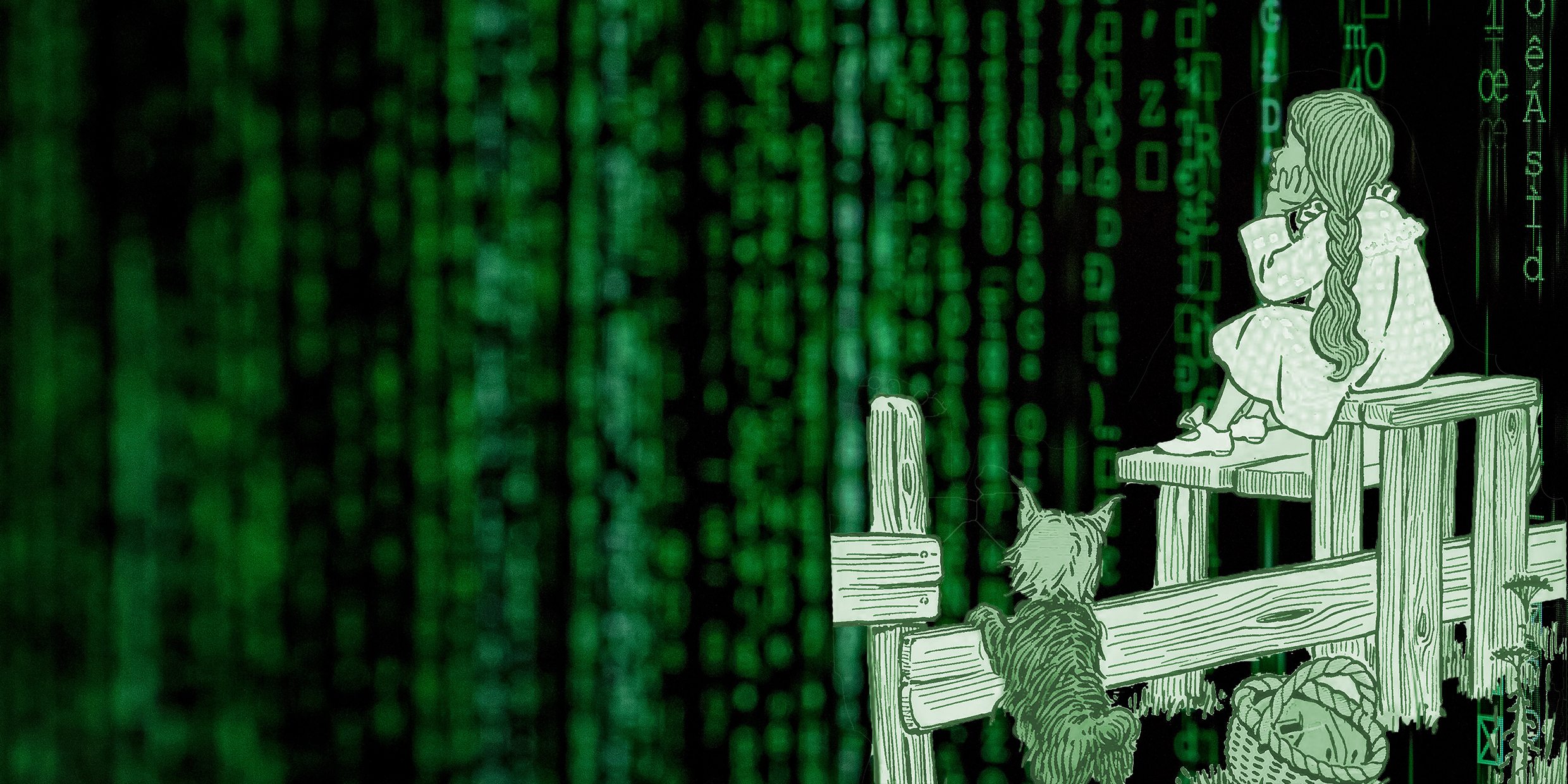Originally published 18 November 1991
“Good gracious, Toto, I don’t think we are in Kansas anymore.”
No, Dorothy, this isn’t Kansas. It’s Cyberland. You and your dog were picked up by the cyclone of history and plunked down here.
“Oh! A talking scarecrow! Can you tell me, are we far from Kansas?”
Not far. Only about ten or twenty years.
“Whose feet are those sticking out from under Uncle Henry’s and Aunt Em’s house? Oh dear! The house must have fallen on her.”
That’s the Witch of the East, Dorothy. Don’t worry about her. She was obsolete, anyway. Just look at her wand. A plain old stick. These days witches use SmartWands, with microcomputers networked directly to the Silicon City and the Wizard of Cyberland.
“You seem so smart for a scarecrow. Back in Kansas our scarecrows have straw in their heads.”
Ha! So there you have it. Cyberland scarecrows are intelligent. Our heads are fitted with computers that enable us to respond with maximum efficiency to the nuisance of crows. We’re networked too, via fiber optic cable, to the Wizard’s ultrahigh-speed mainframe computer. The Wizard knows exactly how many crows we have scared, and we know exactly when the crows are coming our way.
“Who is this Wizard? Is he a good man?”
He is a good wizard, but whether he is a man or not I cannot tell, for I have never seen him. Perhaps he is a supercomputer. Perhaps he is the network of all the computers in Cyberland.
“If I go to see him, can he help me get home to Kansas?”
I’m sure he’ll help you, but there’s no need to go to him. Here in Cyberland everything is done by e‑mail. I can remember the time when if you wanted to go to the Silicon City you followed the yellow brick road. Not anymore. Every computer in Cyberland is connected to every other computer. Communication and information is passed almost instantaneously from place to place.
“Gracious. I never heard of anything like that in Kansas.”
In Cyberland we have reached the fourth stage of computer technology. In the first stage, back in the 1960s, there were just a few big computers. People came to the computers and used them for one task at a time. Then came time-sharing in the 1970s. One big computer serviced lots of terminals and worked on many tasks at once. In the third stage, during the 80s, computers had become so cheap and powerful that anybody who wanted one could have one on their desktop. Now in Cyberland most personal computers are connected together, and linked to huge databases and supercomputers. Even a scarecrow like me has instant access to…
“I think I should like to see the Wizard as soon as possible.”
…all of the information in the Silicon City libraries, business data, sports events, travel and restaurant reservations.
“I’m afraid I could never learn how to use a computer.”
Ah, Dorothy, that’s the beauty of things in Cyberland. Computers have become so ubiquitous that they are invisible. As easy to use as flicking a switch to turn on the lights. Let’s say that I wanted to travel to the Silicon City. I point to ‘Travel’ on the big high-resolution screen of my TV-Infostation. A map appears. I point to the Silicon City. A menu comes up with travel preferences — time of day for travel, seating preferences, that sort of thing. I point to my choices. Flight options appear. I point. A reservation is made. The cost of the ticket is deducted from my bank account. Later on, if there is a change or delay, that information too will appear on my screen.
“Can I book a flight to Kansas?”
In Cyberland, travel agents are a thing of the past. As are mail carriers, FAX machines, the Yellow Pages, video cassettes, merchandise catalogs. Even television news programs are personalized. Did you know that thousands of hours of television programming can be transmitted to your TV over fiber cable during a typical day, far, far more than you could ever watch. Here in Cyberland, our TV-Infostations have memory and interactive display. We can pick and choose what we want to see, and in how much depth. We are freed at last from constraints of space and time. Here in my cornfield I have access to all the information in the land.
“My goodness, I don’t think I should know what to do with so much information. I think I would rather sit in the hayloft and watch Uncle Henry milk his cows.”
Get with it, Dorothy. Where else but in Cyberland could a scarecrow like me know as much as the Wizard? Where else could my pal the Tin Woodman have access to lots and lots of friends — without going out in the rain. Ubiquitous computers! Unlimited information! Just ask me what you want from my Infostation. Bach or hard rock in cornfield-filling stereo? Tonight’s specials at our local restaurant? A classic movie? The latest stock market reports from the Silicon City?…
“I wonder if this Wizard really cares so much about me.”
…Play games? Read a rare book? Check the weather reports from anywhere on earth?…
“I should just like to see my Aunt Em and Uncle Henry.”
…Send a letter to your Aunt Em? File your income taxes? Check your credit rating? See all the property for sale in Cyberland?…
“Oh dear, Toto. I’m beginning to think we shall never get back to Kansas.”
Computer scientist Tim Berners-Lee, the inventor of the World Wide Web, created the first website in December 1990. Since then, neither Cyberland nor Kansas has ever been the same. ‑Ed.



